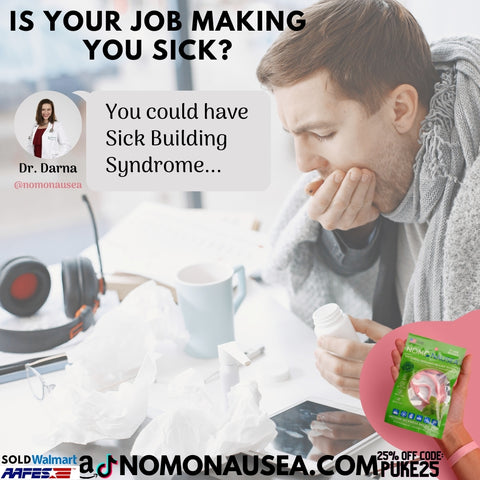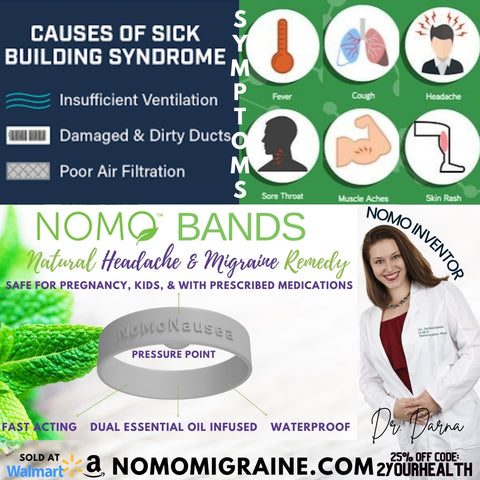
Is my job making me sick? Sick Building Syndrome
Is Your Job Making You Sick? Understanding Sick Building Syndrome
Are you constantly experiencing non-specific symptoms like headaches, nausea, dizziness, or pulmonary problems while at work? You may be suffering from Sick Building Syndrome, also known as multiple chemical sensitivity or environmental illness.
Many occupations put individuals at risk, especially those that deal with unventilated chemicals. If you work in industries like automobile manufacturing, plumbing, funeral services with formaldehyde exposure, or even as a cleaning lady, at a hookah bar, or near strong fragrances at a cosmetic counter, you could be vulnerable to developing this condition.


Relieve Your Symptoms with the No Mo Nausea Band
The No Mo Nausea Band provides a natural and effective solution to alleviate your Sick Building Syndrome symptoms. Utilizing the power of acupressure and peppermint aromatherapy, this innovative band offers fast-acting relief without the use of harmful drugs.
With the No Mo Nausea Band by your side, you can instantly experience relief from your headaches, nausea, dizziness, and other discomforts. Say goodbye to the worries of adding more chemicals to your system and embrace the benefits of a natural solution.

Practical Tips to Improve Your Work Environment
While using the No Mo Nausea Band can alleviate your symptoms, it's also important to make changes in your work environment to prevent future issues. Here are some practical tips to consider:
1. Improve Ventilation
If your workplace is poorly ventilated, it can contribute to the buildup of harmful chemicals or allergens. Talk to your employer about improving ventilation systems or open windows whenever possible.
2. Minimize Exposure
If your job involves exposure to chemicals or substances that trigger your symptoms, take steps to minimize contact. Use protective wear, work in well-ventilated areas, and follow safety protocols to reduce your risk.
3. Take Breaks and Move Around
Regular breaks can help you relieve stress and refresh your mind and body. Use this time to get some fresh air, stretch your legs, and take a mental break from your work environment.
Try NoMo Nausea for Instant Relief
Ready to find relief from Sick Building Syndrome? Purchase the No Mo Nausea Band, a 3:1 essential oil-infused pressure bracelet designed to instantly stop nausea and vomiting caused by motion sickness, morning sickness during pregnancy, and nausea related to chemotherapy in just 30 seconds.
Improve your work experience and reclaim your health with No Mo Nausea Band. Order yours today and start feeling better!

Common Sources of Sick Building Syndrome
If you suspect that your job is making you sick, it's important to know the common sources of Sick Building Syndrome. While we mentioned a few occupations earlier, there are several other industries and conditions that can contribute to this condition. Here are some additional factors to consider:
Poor Indoor Air Quality
Indoor air pollution can contribute to Sick Building Syndrome. Buildings with inadequate ventilation systems or high levels of indoor pollutants, such as mold, dust, or chemicals, can worsen symptoms. This can be especially problematic in older buildings or those without proper maintenance.
Sick Building Materials
The materials used in construction or renovation can release pollutants into the air, potentially causing health problems. Common culprits include volatile organic compounds (VOCs) found in paint, adhesives, carpets, and furniture. These chemicals can off-gas and contribute to symptoms experienced by individuals in these buildings.
Inadequate Cleaning Practices
Poor cleaning practices can lead to the buildup of dust, allergens, and other pollutants in the workplace. High levels of these contaminants can trigger symptoms of Sick Building Syndrome. Regular and thorough cleaning, using safe and eco-friendly products, is essential to maintaining a healthy work environment.
Identifying Symptoms of Sick Building Syndrome
It's crucial to be able to identify the symptoms of Sick Building Syndrome to seek proper treatment and make necessary changes in your work environment. Here are some common symptoms associated with this condition:
Respiratory Issues
Individuals with Sick Building Syndrome often experience respiratory problems like coughing, wheezing, shortness of breath, or chest tightness. These symptoms may worsen while at work and improve when away from the building.


Headaches and Fatigue
Headaches and fatigue are prevalent symptoms of Sick Building Syndrome. If you find yourself frequently experiencing headaches or feeling tired and lethargic during work hours, it may be worth investigating whether your workplace environment is a contributing factor.
Irritated Skin and Eyes
Sick Building Syndrome can also manifest as irritated or itchy skin and eyes. If you notice redness, dryness, or a burning sensation in your eyes, or if your skin becomes irritated or develops a rash while at work, it could be a sign of the condition.
Creating a Healthy Work Environment
Implementing changes to create a healthy work environment is crucial for preventing and managing Sick Building Syndrome symptoms. Here are some practical tips to improve your workspace:
Ensure Proper Ventilation
Good ventilation is essential for maintaining indoor air quality. Make sure that air vents are clean and functioning correctly. If your workplace lacks proper ventilation, consider bringing it up with your employer or facilities management.
Use Natural Cleaning Products
Switching to natural, non-toxic cleaning products can significantly improve indoor air quality. Look for eco-friendly alternatives to harsh chemicals to reduce the risk of triggering symptoms for yourself and your colleagues.
Introduce Indoor Plants
Indoor plants can help improve air quality by absorbing carbon dioxide and releasing oxygen. Additionally, they can add a touch of nature to your workspace, creating a more pleasant and calming environment.
Frequently Asked Questions about Sick Building Syndrome
1. Can Sick Building Syndrome be cured?
Sick Building Syndrome is a condition that can be managed but not cured. By implementing the right changes in your work environment, you can significantly reduce symptoms and improve your overall well-being.
2. How long does it take to recover from Sick Building Syndrome?
The recovery time from Sick Building Syndrome varies from person to person. Some individuals may experience relief once changes are made to their work environment, while others may still require ongoing management of their symptoms.
3. Can Sick Building Syndrome cause long-term health problems?
While Sick Building Syndrome itself is not considered a long-term health problem, the symptoms can be disruptive and affect daily life. If left unaddressed, the prolonged exposure to poor indoor air quality can potentially contribute to the development of respiratory or other health conditions.
By understanding the causes, symptoms, and ways to create a healthier work environment, you can take proactive steps to alleviate Sick Building Syndrome symptoms and improve your overall quality of life. Remember, your well-being is important, and making changes in your workplace can make a significant difference.
Buy the Best Motion Sickness Bracelet
NoMo Nausea is a 3 and 1 essential oil infused pressure bracelet that is clinically proven to stop nausea or vomiting in seconds. Imagine a life with a comfortable pregnancy, and enjoyable day at sea, a family fun car trip, or just a hangover free weekend? That's what NoMo Nausea bracelet can do for you. So say no more to your nausea or upset stomach.
You can find NoMo Nausea on https://nomonausea.com and get 25% off with the coupon PUKE25.

Dr. in Naturopathy answers
- How can Sick Building Syndrome affect my health - Tips to improve my work environment and alleviate symptoms - Is there a connection between my job and feeling sick - Ways to create a healthier workplace for better quality of life - Practical solutions for dealing with Sick Building Syndrome Discover the link between workplace environments and your health in Is Your Job Making You Sick? Learn more about Sick Building Syndrome and how to create a healthier workplace for a better quality of life on our blog. Visit https://nomonausea.com/blogs/healthandwellness/19144999-is-my-job-making-me-sick-sick-building-syndrome for more information.
Can NOMO NAUSEA wristbands for pregnancy provide nausea relief for pregnant women? These nausea bands can!
Do you have nausea in pregnancy? Or know someone who has terrible pregnancy sickness, also known as morning sickness? Discover who these nausea wristbands for pregnancy work best for. Seeking nausea relief & pregnant... Women, these acupressure bracelets known as the waterproof and peppermint scented sea bands called NOMO NAUSEA can truly alleviate morning sickness during pregnancy in 30 seconds or less. Invented by a pregnant doctor who suffered with terrible nausea during and after giving birth, hence why this Dr. in Naturopathy continues exploring the causes of pregnancy nausea and the science behind these natural remedies on NoMo Nausea's blog, and then explore similar topics on our website at https://nomonausea.com/blogs/healthandwellness. Buy the Best Anti-Nausea Bands called No More Nausea Bands, motion sickness bracelets for pregnancy, now for only $12 on Amazon at www.amazon.com/nomonausea.

Buy the Best Morning Sickness Bracelet

